overheating TOYOTA HIGHLANDER HYBRID 2022 Owners Manual
[x] Cancel search | Manufacturer: TOYOTA, Model Year: 2022, Model line: HIGHLANDER HYBRID, Model: TOYOTA HIGHLANDER HYBRID 2022Pages: 572, PDF Size: 14.5 MB
Page 13 of 572

13Pictorial index
Precautions for winter season.............................................. P.330
To prevent freezing (windshiel d wiper de-icer) ..................... P.342
Precautions for car wash
*.................................................... P.399
Fuel filler door ............................................... ..................... P.240
Refueling method ............................................... .................. P.240
Fuel type/fuel tan k capacity ................................... .............. P.509
Tires.......................................................... ........................... P.422
Tire size/inflation pressure ................................... ........ P.422, 513
Winter tires/tire chains ....................................... .................. P.330
Checking/rotation/tire pressur e warning system ..................P.422
Coping with flat tires......................................... .................... P.479
Hood ........................................................... ......................... P.412
Opening ............................................................................... P.412
Engine oil ..................................................... ........................ P.510
Coping with overheating ...................................................... P.502
Warning messages ............................................... ............... P.474
Front turn signal lights/parking lights
*................... P.222P.229
Parking lights
*............................................................... ..... P.229
Headlights/daytime running lights
*.................................. P.229
Headlights..................................................... ...................... P.229
Daytime running lights .. .................................................... P.229
Front side marker lights ....................................... ............. P.229
Parking lights
*/daytime running lights*........................... P.229
Front fog lights ............................................... .................... P.235
Stop/tail lights ............................................... ..................... P.229
Tail lights.................................................... ......................... P.229
Back-up lights
Shifting the shift lever to R ................................................... P.219
Light bulbs of the exterior lights for driving
(Replacing method: P.447, Watts: P.514)
Page 91 of 572
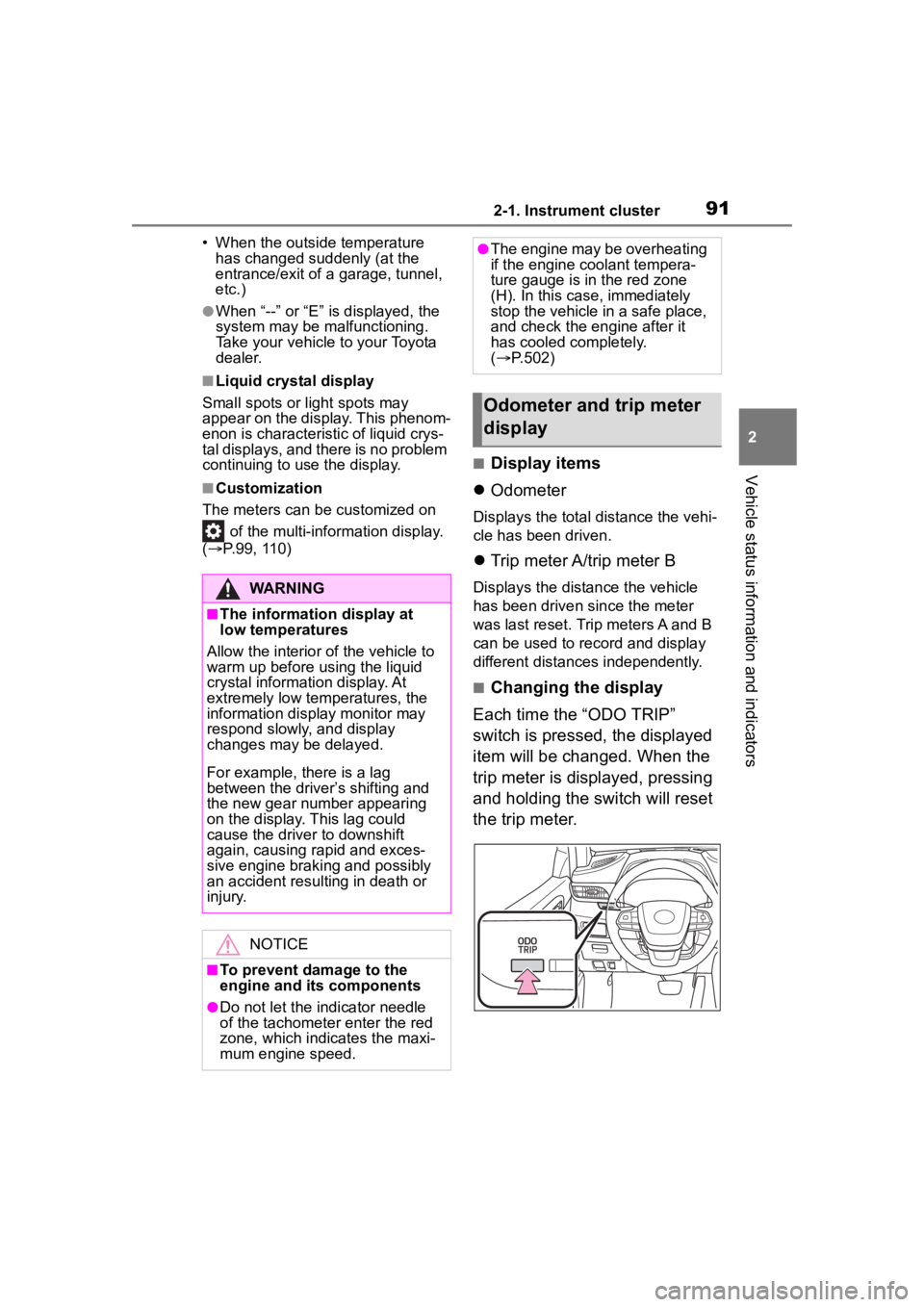
912-1. Instrument cluster
2
Vehicle status information and indicators
• When the outside temperature has changed suddenly (at the
entrance/exit of a garage, tunnel,
etc.)
●When “--” or “E” is displayed, the
system may be malfunctioning.
Take your vehicle to your Toyota
dealer.
■Liquid crystal display
Small spots or light spots may
appear on the display. This phenom-
enon is characteristi c of liquid crys-
tal displays, and there is no problem
continuing to use the display.
■Customization
The meters can be customized on of the multi-information display.
( P.99, 110)
■Display items
Odometer
Displays the total distance the vehi-
cle has been driven.
Trip meter A/trip meter B
Displays the distance the vehicle
has been driven since the meter
was last reset. Trip meters A and B
can be used to record and display
different distances independently.
■Changing the display
Each time the “ODO TRIP”
switch is pressed, the displayed
item will be changed. When the
trip meter is displayed, pressing
and holding the switch will reset
the trip meter.
WARNING
■The information display at
low temperatures
Allow the interior of the vehicle to
warm up before u sing the liquid
crystal informat ion display. At
extremely low temperatures, the
information display monitor may
respond slowly, and display
changes may be delayed.
For example, there is a lag
between the driver’s shifting and
the new gear number appearing
on the display. This lag could
cause the driver to downshift
again, causing rapid and exces-
sive engine braking and possibly
an accident resulting in death or
injury.
NOTICE
■To prevent damage to the
engine and its components
●Do not let the i ndicator needle
of the tachomete r enter the red
zone, which indicates the maxi-
mum engine speed.
●The engine may be overheating
if the engine coolant tempera-
ture gauge is in the red zone
(H). In this case, immediately
stop the vehicle in a safe place,
and check the engine after it
has cooled completely.
( P.502)
Odometer and trip meter
display
Page 195 of 572
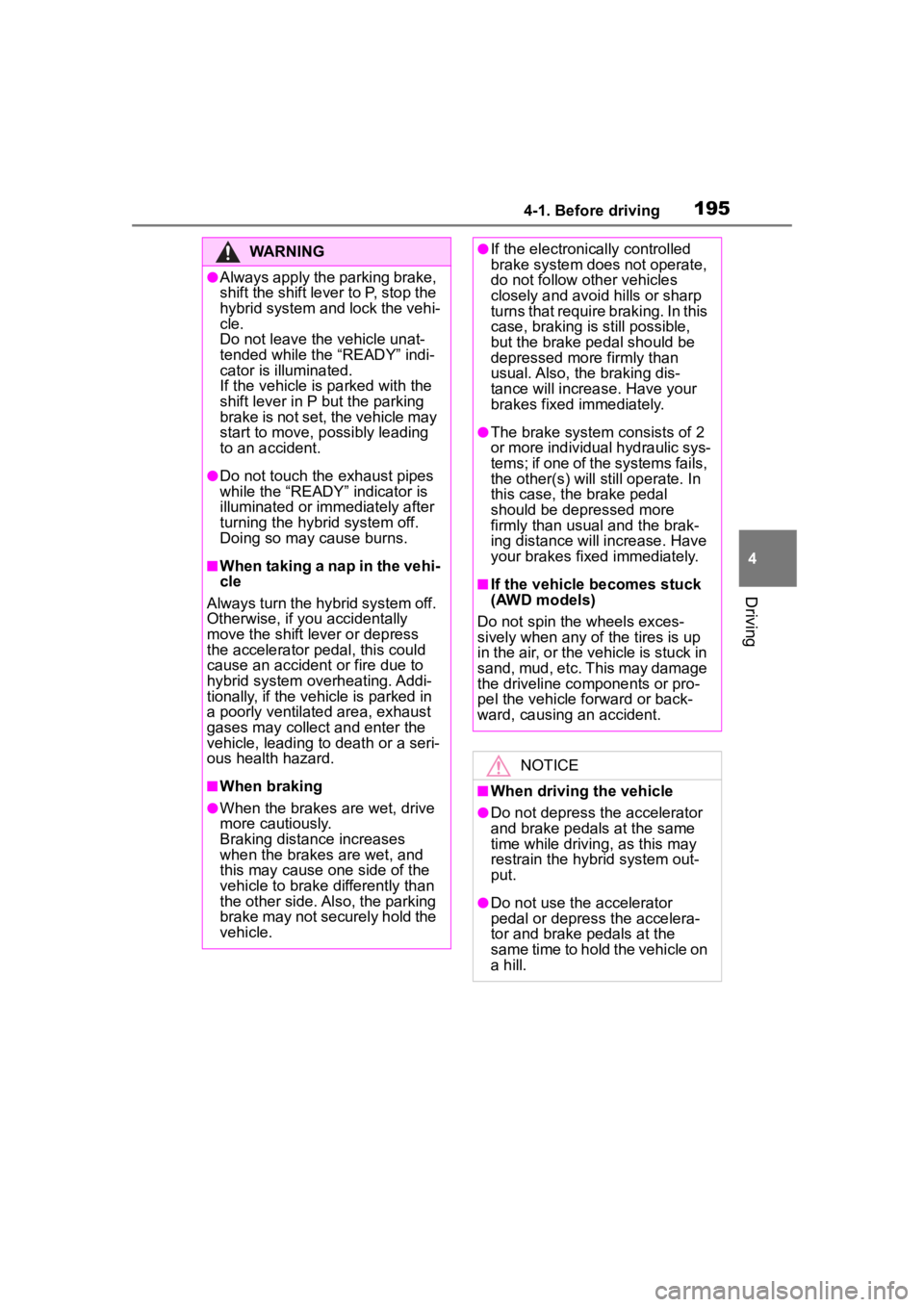
1954-1. Before driving
4
Driving
WARNING
●Always apply the parking brake,
shift the shift lever to P, stop the
hybrid system and lock the vehi-
cle.
Do not leave the vehicle unat-
tended while the “READY” indi-
cator is illuminated.
If the vehicle is parked with the
shift lever in P but the parking
brake is not set, the vehicle may
start to move, possibly leading
to an accident.
●Do not touch the exhaust pipes
while the “READY” indicator is
illuminated or immediately after
turning the hybrid system off.
Doing so may cause burns.
■When taking a nap in the vehi-
cle
Always turn the hybrid system off.
Otherwise, if you accidentally
move the shift lever or depress
the accelerator pedal, this could
cause an accident or fire due to
hybrid system overheating. Addi-
tionally, if the vehicle is parked in
a poorly ventilated area, exhaust
gases may collect and enter the
vehicle, leading to death or a seri-
ous health hazard.
■When braking
●When the brakes a re wet, drive
more cautiously.
Braking distance increases
when the brakes are wet, and
this may cause one side of the
vehicle to brake differently than
the other side. Also, the parking
brake may not securely hold the
vehicle.
●If the electronically controlled
brake system does not operate,
do not follow other vehicles
closely and avoid hills or sharp
turns that require braking. In this
case, braking is still possible,
but the brake pedal should be
depressed more firmly than
usual. Also, the braking dis-
tance will increase. Have your
brakes fixed immediately.
●The brake system consists of 2
or more individual hydraulic sys-
tems; if one of the systems fails,
the other(s) will still operate. In
this case, the brake pedal
should be depressed more
firmly than usual and the brak-
ing distance will increase. Have
your brakes fixed immediately.
■If the vehicle becomes stuck
(AWD models)
Do not spin the wheels exces-
sively when any of the tires is up
in the air, or the vehicle is stuck in
sand, mud, etc. This may damage
the driveline components or pro-
pel the vehicle forward or back-
ward, causing an accident.
NOTICE
■When driving the vehicle
●Do not depress the accelerator
and brake pedals at the same
time while driving, as this may
restrain the hybrid system out-
put.
●Do not use the accelerator
pedal or depress the accelera-
tor and brake pedals at the
same time to hold the vehicle on
a hill.
Page 211 of 572

2114-1. Before driving
4
Driving
or steep grade. If the engine
coolant temperature gauge
indicates overheating, imme-
diately turn off the air condi-
tioning (if in use), pull your
vehicle off the road and stop
in a safe spot. (P.502)
Always place wheel blocks
under both the vehicle’s and
the trailer’s wheels when
parking. Put the transmission
in P and apply the parking
brake. Avoid parking on a
slope, but if unavoidable, do
so only after performing the
following:
1 Apply the brakes and keep
them applied.
2 Have someone place wheel
blocks under both the vehi-
cle’s and trailer’s wheels.
3 When the wheel blocks are in
place, release the brakes
slowly until the blocks absorb
the load.
4 Shift into P and apply the
parking brake.
5 Turn off the hybrid system.
When restarting after parking
on a slope:
1 With the transmission in P,
start the hybrid system. Be
sure to keep the brake pedal
depressed.
2 Shift into a forward gear. If
reversing, shift into R. 3
If the parking brake is in man-
ual mode, release the park-
ing brake. ( P.223)
4 Release the brake pedal, and
slowly pull or back away from
the wheel blocks. Stop and
apply the brakes.
5 Have someone retrieve the
blocks.
Page 225 of 572
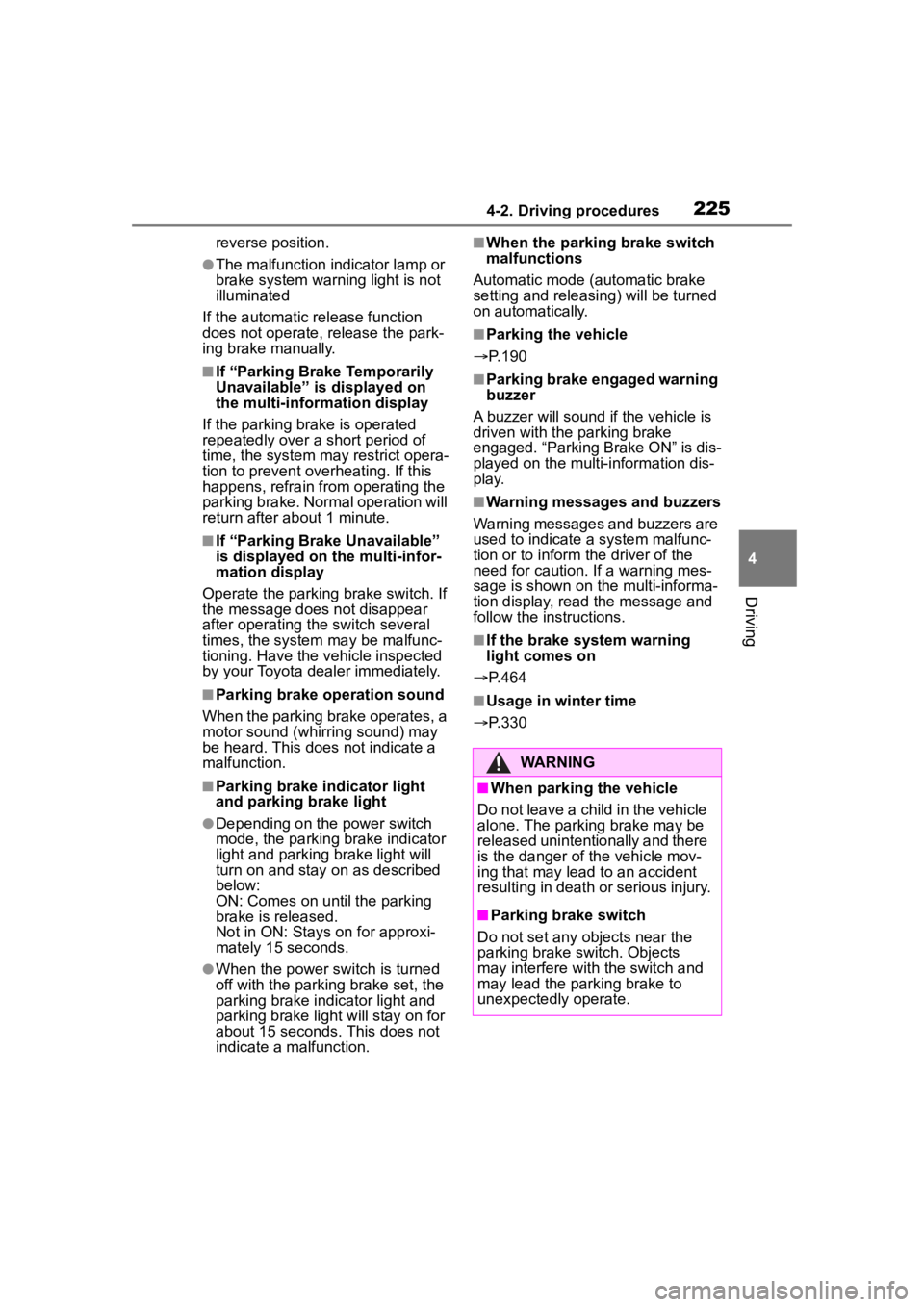
2254-2. Driving procedures
4
Driving
reverse position.
●The malfunction indicator lamp or
brake system warning light is not
illuminated
If the automatic release function
does not operate, release the park-
ing brake manually.
■If “Parking Brake Temporarily
Unavailable” i s displayed on
the multi-information display
If the parking brake is operated
repeatedly over a short period of
time, the system may restrict opera-
tion to prevent overheating. If this
happens, refrain from operating the
parking brake. Nor mal operation will
return after about 1 minute.
■If “Parking Brake Unavailable”
is displayed on the multi-infor-
mation display
Operate the parking brake switch. If
the message does not disappear
after operating the switch several
times, the system may be malfunc-
tioning. Have the vehicle inspected
by your Toyota dealer immediately.
■Parking brake operation sound
When the parking brake operates, a
motor sound (whirring sound) may
be heard. This does not indicate a
malfunction.
■Parking brake indicator light
and parking brake light
●Depending on the power switch
mode, the parking brake indicator
light and parking brake light will
turn on and stay on as described
below:
ON: Comes on until the parking
brake is released.
Not in ON: Stays on for approxi-
mately 15 seconds.
●When the power switch is turned
off with the parking brake set, the
parking brake indicator light and
parking brake light will stay on for
about 15 seconds. This does not
indicate a malfunction.
■When the parking brake switch
malfunctions
Automatic mode (automatic brake
setting and releas ing) will be turned
on automatically.
■Parking the vehicle
P.190
■Parking brake engaged warning
buzzer
A buzzer will sound if the vehicle is
driven with the parking brake
engaged. “Parking Brake ON” is dis-
played on the multi-information dis-
play.
■Warning messages and buzzers
Warning messages and buzzers are
used to indicate a system malfunc-
tion or to inform the driver of the
need for caution. If a warning mes-
sage is shown on the multi-informa-
tion display, read the message and
follow the instructions.
■If the brake system warning
light comes on
P.464
■Usage in winter time
P.330
WARNING
■When parking the vehicle
Do not leave a child in the vehicle
alone. The parking brake may be
released unintentionally and there
is the danger of the vehicle mov-
ing that may lead to an accident
resulting in death o r serious injury.
■Parking brake switch
Do not set any objects near the
parking brake switch. Objects
may interfere with the switch and
may lead the parking brake to
unexpectedly operate.
Page 226 of 572
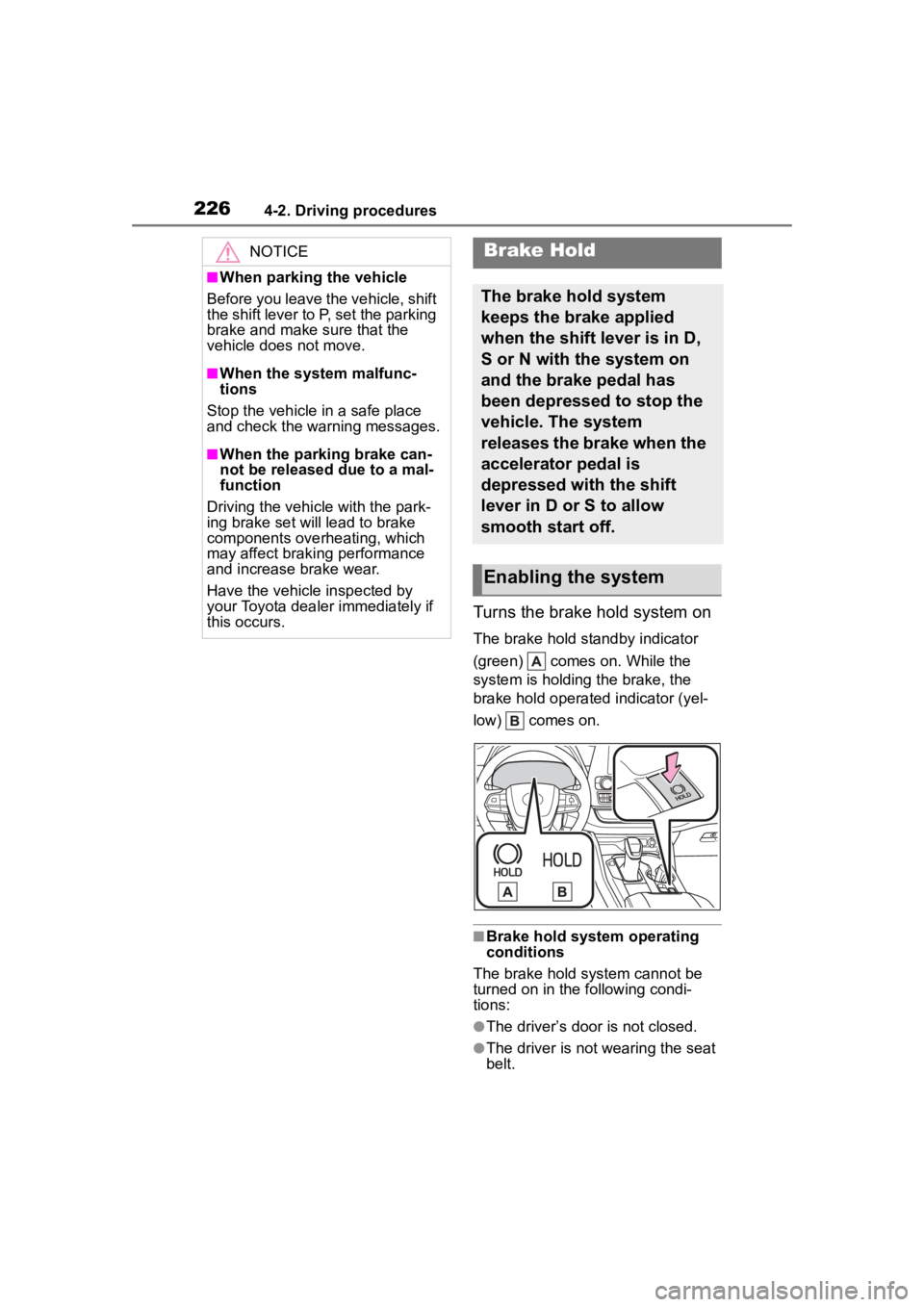
2264-2. Driving procedures
Turns the brake hold system on
The brake hold standby indicator
(green) comes on. While the
system is holding the brake, the
brake hold operated indicator (yel-
low) comes on.
■Brake hold system operating
conditions
The brake hold system cannot be
turned on in the following condi-
tions:
●The driver’s door is not closed.
●The driver is not wearing the seat
belt.
NOTICE
■When parking the vehicle
Before you leave the vehicle, shift
the shift lever to P, set the parking
brake and make sure that the
vehicle does not move.
■When the system malfunc-
tions
Stop the vehicle in a safe place
and check the warning messages.
■When the parking brake can-
not be released due to a mal-
function
Driving the vehicle with the park-
ing brake set will lead to brake
components overheating, which
may affect braking performance
and increase brake wear.
Have the vehicle inspected by
your Toyota dealer immediately if
this occurs.
Brake Hold
The brake hold system
keeps the brake applied
when the shift lever is in D,
S or N with the system on
and the brake pedal has
been depressed to stop the
vehicle. The system
releases the brake when the
accelerator pedal is
depressed with the shift
lever in D or S to allow
smooth start off.
Enabling the system
Page 325 of 572

3254-5. Using the driving support systems
4
Driving
■Active Cornering Assist opera-
tion sounds and vibrations
When the Active Cornering Assist is
operated, operation sounds and
vibrations may b e generated from
the brake system, but this is not a
malfunction.
■EPS operation sound
When the steering wheel is oper-
ated, a motor sou nd (whirring
sound) may be heard. This does not
indicate a malfunction.
■Reduced effectiveness of the
EPS system
The effectiveness of the EPS sys-
tem is reduced to prevent the sys-
tem from overheating when there is
frequent steering input over an
extended period of time. The steer-
ing wheel may feel heavy as a
result. Should this occur, refrain
from excessive steering input or
stop the vehicle and turn the hybrid
system off. The E PS system should
return to normal within 10 minutes.
■Automatic reactivation of
TRAC, Trailer Sway Control and
VSC systems
After turning the TRAC, Trailer
Sway Control and VSC systems off,
the systems will be automatically
re-enabled in the following situa-
tions:
●When the power switch is turned
OFF
●If only the TRAC system is turned
off, the TRAC will turn on when
vehicle speed increases
If both the TRAC and VSC sys-
tems are turned off, automatic
re-enabling will not occur when
vehicle speed increases.
■Operating conditions of Active
Cornering Assist
The system operates when the fol-
lowing occurs.
●TRAC/VSC can operate
●The driver is at tempting to accel- erate while turning
●The system detects that the vehi-
cle is drifting to the outer side
●The brake pedal is released
■If a messege about AWD is
shown on the multi-information
display (AWD models)
Perform the following actions.
●“AWD System Overheated
Switching to 2WD Mode.” AWD
system is overheated. Stop the
vehicle in a safe place with the
hybrid system operating. If the
message disappears after a while,
there is no problem. If the mes-
sage remains, have the vehicle
inspected by your Toyota dealer
immediately.
●“AWD System Overheated 2WD
Mode Engaged.” AWD system
has been temporarily released
and switched to front-wheel drive
due to overheating. Stop the vehi-
cle in a safe place with the hybrid
system operating. If the message
disappears after a while, AWD
system will automatically recover.
If the message remains, have the
vehicle inspected by your Toyota
dealer immediately.
●“AWD system Malfunction 2WD
Mode Engaged Visit Your Dealer.”
A malfunction occurs in the AWD
system. Have the vehicle
inspected by your Toyota dealer
immediately.
*: When stopping the vehicle, do not stop the hybrid system until the
display message has turned off.
■Secondary Collision Brake
operating conditions
The system operates when the SRS
airbag sensor de tects a collision
while the vehicle is in motion.
However, the system does not oper-
ate in any of the following situations.
●The vehicle speed is below 6 mph
(10 km/h)
Page 358 of 572
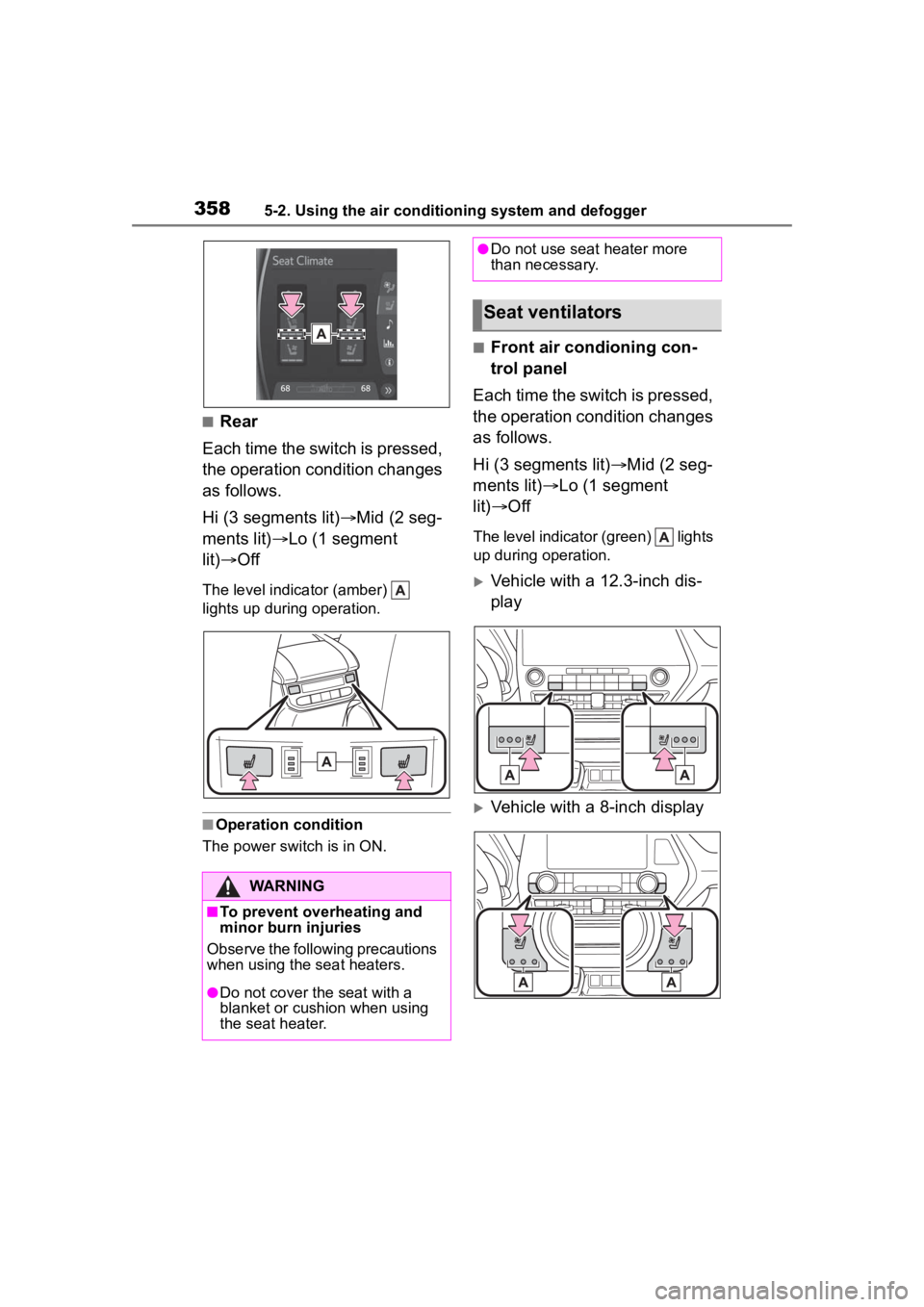
3585-2. Using the air conditioning system and defogger
■Rear
Each time the switch is pressed,
the operation condition changes
as follows.
Hi (3 segments lit) Mid (2 seg-
ments lit) Lo (1 segment
lit) Off
The level indica tor (amber)
lights up during operation.
■Operation condition
The power swit ch is in ON.
■Front air condioning con-
trol panel
Each time the switch is pressed,
the operation condition changes
as follows.
Hi (3 segments lit) Mid (2 seg-
ments lit) Lo (1 segment
lit) Off
The level indicato r (green) lights
up during operation.
Vehicle with a 12.3-inch dis-
play
Vehicle with a 8-inch display
WARNING
■To prevent overheating and
minor burn injuries
Observe the following precautions
when using the seat heaters.
●Do not cover the seat with a
blanket or cushion when using
the seat heater.
●Do not use seat heater more
than necessary.
Seat ventilators
Page 558 of 572

558Alphabetical Index
Back-up lightsReplacing light bulbs ............ 447
Battery (12-volt battery) Battery checking................... 419
If the 12-volt battery is dis-charged .............................. 497
Preparing and c hecking before
winter.................................. 330
Replacing ............................. 500
Warning light ........................ 465
Battery (traction battery) ......... 75
Blind Spot Monitor (BSM) ...... 286
Brake Brake hold ............................ 226
Fluid ............................. 418, 513
Parking brake ....................... 223
Regenerative braking ............. 72
Warning light ........................ 464
Brake assist ............................ 322
Break-in tips ........ ................... 191
Brightness control Instrument panel light control . 92
BSM (Blind Spot Monitor) ...... 286
Buzzer Hands off steering wheel warn-ing (LTA) ............................. 269
C
Care Exterior ................................. 398
Interior .................................. 401
Seat belts ............................. 401
Wheels and wheel ornaments........................................... 398
Cargo capacity ....................... 200
Cargo net hooks .. ................... 368
Chains ..................................... 331
Child restraint system Fixed with a LATCH system ... 60
Fixed with a seat belt ............. 55
Front passenger occupant clas-sification system ................... 43 Points to remember ................50
Riding with children ................49
Types of child restraint system
installation method ...............52
Using an anchor bracket ........62
Child safety 12-volt battery precautions .420, 501
Airbag precautions .................39
Back door precautions..........135
Child restraint system .............52
Heated steering wheel and seat heater precautio ns..............356
How your child should wear the seat belt ................................28
Moon roof precautions..........183
Panoramic moon roof precau- tions ....................................187
Power window lock switch ....181
Power window precautions...180
Rear door child-protectors ....134
Seat belt extender precautions .............................................29
Seat belt precautions..............49
Child-protectors......................134
Cleaning Exterior .................................398
Interior ..................................401
Radar sensor ........................244
Seat belts .............................401
Wheels and wheel ornaments...........................................398
Clock ....................................89, 92
Coat hooks ..............................381
Condenser ............. ..................417
Console box ............................364
Conversation mirror ...............387
Cooling system .......................416 Engine overheating ..............502
Hybrid system overheating ...504
Page 560 of 572

560Alphabetical Index
EDR (Event data recorder)......... 7
E-Four ...................................... 323
Elapsed time ..................... 96, 106
Electric motor (traction motor)71
Electric Power Steering (EPS)............................................... 323Warning light ........................ 467
Electronic key ......................... 128 Battery-saving function......... 147
If the electronic key does not operate properly ................. 495
Replacing the battery ........... 442
Electronic roof sunshade Jam protection function ........ 186
Operation ............................. 185
Electronically Controlled Brake System (ECB) ....................... 322
Emergency flashers ............... 456
Emergency, in case of If a warning buzzer sounds .. 464
If a warning light turns on ..... 464
If a warning message is dis-played................................. 474
If the 12-volt battery is dis- charged .............................. 497
If the electronic key does not operate properly ................. 495
If the fuel filler door cannot be opened ............................... 494
If the hybrid sy stem will not start
........................................... 492
If the vehicle is submerged or water on the road is rising .. 457
If you have a flat tire ............. 479
If you lose your keys ............ 493
If you think something is wrong ........................................... 462
If your vehicle becomes stuck ........................................... 506
If your vehicle has to be stopped in an emergency................. 456 If your vehicle needs to be towed
...........................................459
If your vehicle ove rheats ......502
Energy monitor ....................... 117
Engine ACCESSORY mode . ............215
Compartment........................414
Engine switch .......................213
Hood .....................................412
How to start the hybrid system ...........................................213
Identification number ............509
If the hybrid sys tem will not start
...........................................492
If your vehicle has to be stopped in an emergency .................456
Ignition switch (power switch) ...........................................213
Overheating ..........................502
Power switch ........................213
Tachometer.............................89
Engine coolant Capacity ............................... 511
Checking ..............................416
Preparing and checking before winter ..................................330
Engine coolant temperature gauge .......................................89
Engine oil Capacity ...............................510
Checking ..............................414
Preparing and checking before winter ..................................330
Warning light.........................465
Engine switch (power switch)213 If your vehicle has to be stopped in an emergency .................456
EPS (Electric Po wer Steering)
...............................................323 Warning light.........................467
EV drive mode.........................217
EV indicator...............................72